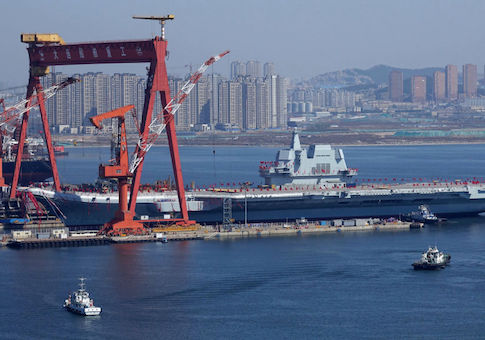SINGAPORE—China's launch of its first homegrown aircraft carrier on Wednesday could be the beginning of a financial train wreck, according to carrier design and construction specialists.
Unless seriously revised, China's plans for its future carrier force could become a major financial difficulty for the country. The resources poured into aircraft carriers are a massive budgetary burden, even in the United States, according to Andrew Marshall, former director of the Pentagon's Office of Net Assessment.
China's first "indigenous" aircraft carrier, assigned the hull number of CV-17, is expected to be named the Shandong and will be slightly larger at 70,000 tons than the CV-16, China's first-ever aircraft carrier.
The CV-17, characterized by the Chinese as a "homegrown" design, is an upgraded version of the Liaoning. The Soviet-built Liaoning, however, was not developed either in China or with China's naval requirements in mind. Ukraine sold the unfinished ship in 1998 to Chinese middlemen "pretending to have no connection to the navy," according to one China military analyst in Washington. "This was done under the ridiculous pretense that the carrier would be tied up at the docks in Macau to become a floating casino painted in battleship grey."
The ship was eventually towed to the Dalian shipyards, where it underwent more than a decade of re-fitting as the People's Liberation Army Navy worked to develop aircraft for carrier-based use.
This new carrier will be "just enough different from the Liaoning that the PLAN will enjoy minimal benefits—if any—and no synergism from having two similarly-designed ships," according to a U.S. aircraft carrier design specialist who spoke to the Washington Free Beacon. The troubles that the Chinese will have with their carrier fleet "are only going to multiply geometrically if they follow through on their previously declared plans for future ships."
The PLAN is expected to launch a second carrier in 2021 that will be equipped with a steam catapult similar to that of the U.S. Navy's current fleet of carriers. A subsequent program for a third series of carrier calls for ships to be fitted with an electromagnetic catapult—like that of the U.S. Navy's incoming Gerald Ford-class ships—and to be powered with a nuclear reactor.
Operating a fleet of ships of widely disparate and dissimilar designs "is not the way anyone trying to develop an effective carrier force would do it," said the carrier design specialist. "This could turn out to be logistics nightmare of significant proportions."
A retired U.S. Government naval specialist said the cost of supporting naval vessels would be huge.
"It is a ever-expanding drain on resources that will not become clear to the Chinese until it is too late for them to reverse it," he said. "When you look at the potential of what this could do to the PLAN's future budgets—as well as the other programs that will have to be sacrificed to keep the carriers afloat—it is easy to see why people like [Andrew] Marshall are more sage and less alarmist about the 'coming Chinese carrier threat.'"
